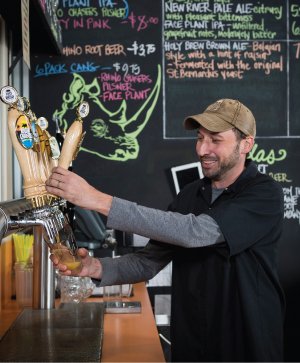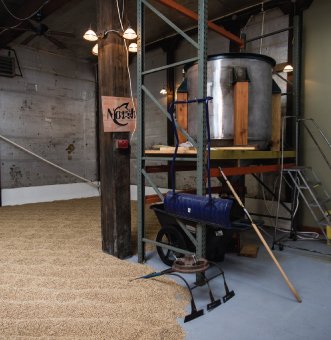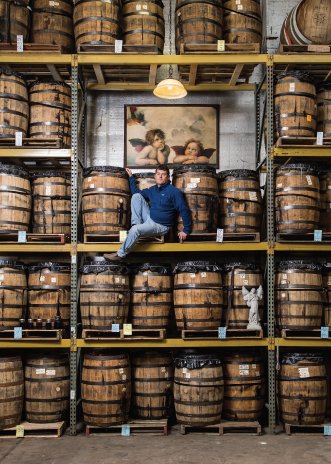Just five years ago, an all-local beer like Native Son might have been nearly impossible to brew. But thanks to the New industry growing around NoVA brewers, such a beer might just be the norm in the near future.
By Tim Regan / Photography By Erick Gibson

Favio Garcia pouring in the Tasting Room at Lost Rhino
Virginia’s golden boy
Lost Rhino Brewing Company co-owner Favio Garcia tugs on a wooden tap handle and pours a golden-amber beer from the spigot. He’s beaming as he fills a taster with a generous amount of frothy liquid, all smiles. “When [the ingredients] became available this summer, it was like, let’s do it. We didn’t even do a test batch or anything.” He’s talking about Native Son, an all-local beer that encapsulates the spirit of Virginia in the same way an English Pale Ale does for England. Normally, brewers might use one or two local ingredients in a beer—if they can find them. Lost Rhino’s Native Son is the first to source each and every ingredient—including the yeast—from right here in the state of Virginia.
Some pieces of the brewing puzzle came together nicely. Aside from needing dechlorination, the local water supply didn’t require many adjustments. “It is coming basically from the mountains,” says Garcia. Cascade hops seem to grow anywhere, and suppliers are abundant. “There’s always people growing hops in the area, you know, backyard stuff … there’s quite a few of them at this point. They get a decent amount harvested,” Garcia says. The hops that lend Native Son its floral notes and bitterness came from Sage Hill Hops Farm in Leesburg. But some other ingredients were trickier to procure. “It’s really kind of hard to do the four basic ingredients locally,” says Garcia. One challenge—how to find local yeast—eluded the brewers at Lost Rhino, until Janelia microbiologist Jasper Akerboom happened to walk through the doors one day to talk brewing and show them his side hobby: taming strains of yeast he collected in his backyard. Several yeast cultures, a wheat beer brewed from his wild yeast and a few months later, Akerboom was hired on full time to oversee the brewery’s in-house yeast production.

Jasper Akerboom
Lost Rhino’s mad scientist
A brewer pours a heap of barley malt into a mash tun—a massive steel cooker used for making beer. These vessels produce hundreds of gallons of wort, a sugar-rich liquid that tastes like liquid Grape Nuts (yes, the cereal). This is the solution Akerboom dumps his homebrew yeast into to make Lost Rhino’s beer. “I do a lot of quality assurance. Testing everything. Making sure the yeast is still healthy. Making sure we get the right numbers, that nothing is contaminated,” says Akerboom. His job is an important one, made evident by the brewery’s growing lab space devoted to yeast research; a lab that one day could fulfill all of the brewery’s yeast needs. Currently, only a few of the brewery’s beers come from Akerboom’s homegrown critters. Native Son is one of them. Birth of Ace Brett IPA is another. Right now, it’s too expensive and time consuming to ferment every beer with Lost Rhino yeast, but Akerboom envisions a day when it might be feasible to do just that. “If we can find yeast that works better than the ones we use, why wouldn’t we use them?”
Despite a big step forward with locally-sourced yeast, Garcia still had one major challenge in creating his Virginia beer. “The malt was the last piece. I thought the yeast was going to be the hardest.” Luckily, there’s one man in the Northern Neck of Virginia growing exactly what they need.

Malt floor with steep tank
Before it’s beer
Picture rows upon rows of crops. Stalks of grain sway in the cool breeze just before sunset. This could be a picturesque Midwestern farm, but this isn’t the Midwest. This is the Northern Neck of Virginia, where grower Billy Dawson transforms rows of wheat and barley into the backbone for our local beer. “I raise everything that we sell out of this little mill,” he says of the 1,200-acre growing operation he calls Avalon Farms. There aren’t too many growers doing what Dawson does. Why? Because most barley crops don’t thrive in the humid, often-rainy Chesapeake environment. “You lose quality when [barley] gets rain on it after it gets ripe.” But that’s changing with time. Though he started growing crack corn and whole corn on his farm in 1986, Dawson only started raising food-grade barley for brewing and distilling in 2006. He’s still getting the hang of it, but this isn’t the first time he’s grown a business from the ground up. “I’d go into these stores and the corn was coming from out of state into Virginia, and I said, ‘This is stupid, I mean why can’t Virginia supply this market?’” says Dawson. But unlike growing corn, barley is a complex beast, at least for local farmers. “I still have to learn a little bit about raising [barley] in the field. We have different weather out here on the East Coast than they do where they raise these types of barley,” he says. Another challenge is the prevalence of parasites and certain molds, which can be managed with the right insecticides and fungicides. But barring wet weather and pests, Virginia has the right nutrient-rich soil to become a larger player in the brewing grains market. “The coastal plains of Virginia are very well-suited for growing barleys,” says Dawson. “The sandy loam soils drain well. Our soils can grow very good barley.” And as long as he can overcome the challenges, the need for local barley is there.

Wasmund in Copper Fox's barrel room
So, who’s currently buying his food grade wheat and barley? Besides Lost Rhino, Copper Fox Distillery in Sperryville uses his barley to make whiskey, and Port City Brewing Company in Alexandria have purchased Dawson’s wheat grains in bulk for one of their flagship beers, Optimal Wit. And with so much business, he’s optimistic that this is the industry he wants to be in. “I get so many phone calls you wouldn’t believe it. It’s very much in demand,” he says. Still, there are some big hurdles, too.
His last crop of malting barley sprouted in the field, rendering it less than ideal, and he hasn’t yet found a way to turn his latest project into a comfortable profit. But for Dawson—who says growing is part business, part hobby—it’s about the cycles of plant, grow and harvest, even though he’s still figuring out the profitability of growing food grade barley. “Sometimes it really doesn’t pan out to be much of a moneymaker but I enjoy that and so I’m willing to try just about anything.” And about that less than ideal crop of barley: Lost Rhino’s Garcia says it’s just part of what makes his job interesting. “The fact that the malt is not perfect is a really unique experience,” he says.
(opened/set to open in 2013)
Badwolf Brewing Company
Manassas
Forge Brew Works
Lorton
Crooked Run Brewery
Leesburg
Beltway Brewing Company
Sterling
Adventure Brewing Company
Fredericksburg
Adroit Theory Brewing Company
Purcellville
Old Ox Brewery
Ashburn
Portner Brewhouse
Alexandria
Heritage Brewing Company
Manassas
Old Bust Head Brewing Company
Fauquier
Building a better barley
You can’t change the weather, but can you change the barley? Virginia Tech scientist Dr. Carl Griffey is looking into it. Along with a team of researchers, he’s designing a hybrid strain of barley malt hardy enough to withstand wet weather and native diseases. The project started in the year 2000 with a simple question: Could Virginia grow indigenous, food-grade barley? “It came about because Rick Wasmund of Copper Fox Distillery wanted to know whether we could malt any of our Virginia barleys. … We had a new variety at that time that was derived from a Virginia barley and a French malting barley variety called Plaisant.” Though the project has evolved for nearly 14 years, Griffey says more time is needed to create the perfect plant. The process goes like this: “Generally, the breeding process is relatively slow. It takes about 15 years until you actually get a [new] variety,” he says. Virginia growers like Dawson have already started to experiment with the new strain—currently dubbed “thoroughbred”—but so far results have been mixed. “They have some weaknesses in both yield potential and disease resistance,” Griffey says. Still, he remains optimistic. “There is a very good chance that we will develop improved varieties and that the malt industry is going to continue to grow in the eastern U.S.,” says Griffey. And with brewers popping up left and right, demand for reliable, locally-sourced brewing grains should remain high.
The ‘missing piece’ of the puzzle
Dawson’s barley is clean. Inspected. Purchased. Before it goes to Lost Rhino, it heads to Sperryville to be transformed from a raw grain into a brewing ingredient.
Grains are the cornerstone of any beer. Traditionally, brewers have used barley in their beers, but it’s also possible to brew with wheat, rye, corn and even sorghum in varying amounts. Rich in sugars, these grains not only provide the basis for complex flavors, but also sustain the yeast nutritionally during fermentation. And depending on the “roast” of the malt, beer projects swaths of colors and flavors. Before it can be brewed the barley must go through a complex process. The raw seeds undergo a step called malting, during which grains are immersed in water for hours at a time over the course of three days. After the water is drained, the grains are allowed to partially germinate, which transforms some of the starches into fermentable and non-fermentable sugars. At Copper Fox, the malt is usually roasted in kilns that hold 1,800 pounds of barley malt, enough to make about 1,000 gallons of whiskey mash or beer.
Normally, a small brewer like Lost Rhino or Port City might buy malted barley from an industrial malthouse as far away as Ohio or Canada. But Charles Wise, Copper Fox Distillery’s “maltrepreneur,” offers a better deal: “We can get it from a grower. We know who the grower is. He’s 125 miles away.” And local brewers are eating it up. “If we can source the quality that we’re looking for in a local product, then we go out of our way to use it,” says Port City owner Bill Butcher, who buys wheat from Dawson and has experimented with Copper Fox barley. Though their main business is whiskey, beer-grade barley malt has been a profitable endeavor for the distillery. Owner Rick Wasmund agrees. “There’s definitely a market,” he says. But even he acknowledges that the market is only now turning the corner. “To some extent, the jury is still out on whether or not Virginia malt will be part of our future,” says Wasmund. And although he’ll talk up Copper Fox whiskey at the drop of a hat, he’s not shy about praising the beer his malted barley creates: “Native Son is a frickin’ fabulous beer,” he says.

(December 2013)